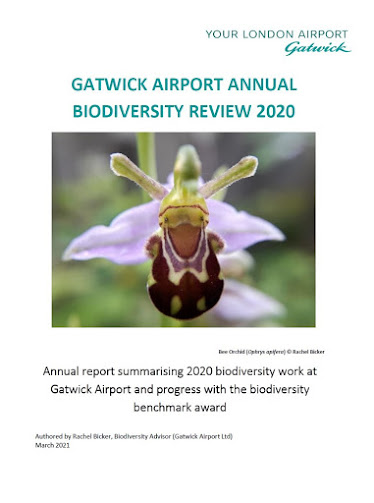Monday 13 December 2021
Small mammals of Gatwick
Thursday 16 September 2021
Long-horned flights
A brief update on Gatwick's colonies of Long-horned Bees (Eucera longicornis) during the 2021 field season.
Thursday 1 July 2021
Rings around the world
Back in May 2016, myself and volunteer Donald were carrying out a reptile survey in the North West Zone when a sudden burst of bird song erupted near my head; a Nightingale was the last thing I'd expected to hear that day! This is a real stand-out moment from my time at Gatwick. I nipped back that same evening to make a recording (this being back in the era of a busy night-time airfield). Ambient noise didn't put this energetic songster off...
Sound only clip (no image)
Nightingales arrive in the UK around late April, having migrated all the way from their overwintering sites in Africa. Checking Gatwick's pan-species list, there are few previous records of Nightingale within the airport boundary. It seemed in 1987 the Hilton Hotel car park (around 3km from the current spot) contained some good scrub habitat which was suitable for their breeding, however in 2021 this area is now a stand of semi-mature trees.
Corridors of good quality habitat are important for dispersing wildlife, especially for highly mobile species such as migrating birds. The River Mole diversion project was completed in the year 2000, resulting over 20 years later in a 3.5km length of meandering floodplain meadow, bordered by sloping species-rich grassland, graduating into scrub and mature woodland.
The bird ringing scheme, overseen by the British Trust for Ornithology (BTO), gathers data on the survival, productivity and movements of birds, which is important in understanding why populations are changing. Recovered rings have told some pretty surprising things over the years, causing our estimates of wild bird life-spans and travel distances to be revised. It is an intensive undertaking which involves a lot of special training. Fortunately several of the ecologists we work with happen to be licenced bird ringers!
Jon Middleton is an aviation ornithologist for Birdstrike Management Ltd, who visits Gatwick Airport as a consultant several times a year. In his spare time, Jon is an avid bird ringer and after hearing about our two Nightingale territories, he offered his help with Nightingale Territory 1; the original, un-ringed male.
Tuesday 23 March 2021
Gatwick Airport's Annual Biodiversity Review 2020
Gatwick Airport’s Annual Biodiversity Review is here again, and despite the challenges from Covid-19 in 2020 we’ve been able to pull together loads of fascinating information and records of our local wildlife. A huge thank you to everyone who contributed to the project in 2020.
Gatwick Airport Annual Biodiversity Review 2020
Tuesday 16 February 2021
The importance of wildlife records
- Pulling together old and new information for every single species, such as when it was first recorded, when it was last recorded, the sites on which it has occurred, any conservation designations it has or previously had and a precise location where it might be found.
- Filtering by conservation designation helps us to identify our most rare and vulnerable species - below I can see that 25 of our moths have some sort of status for their conservation, but I also see that we have only entered moth records up to 2018, so there are probably more to add.
- Gaps in our monitoring: 300 species of fungi demonstrates a high recording effort (mostly all down to Nick Aplin of Sussex Fungi Group!), but 11 species of lichen is not much and we haven't a single species record for algae.
- Species lost: 6 bird species haven’t been recorded since 1997, at least 4 of which had previously been breeding here. By cross-checking with the bird conservation organisations, we can see these particular species have been declining nationally.
- Identifying useful surveys: at least 138 invertebrate species were picked up from the water quality monitoring reports by a third-party consultant, regularly undertaken since 2011.
- Data flow issues: by sending copies of our list to individual wildlife recording schemes, they can indicate where they are waiting on relevant data from us.
- Highlighting importance of partnership work: without the huge database of records collected and centralised by the Sussex Biodiversity Record Centre, a comprehensive list would not be possible. They ensure that the wider data is kept safe, reaching the relevant wildlife recording schemes and conservation organisations.































